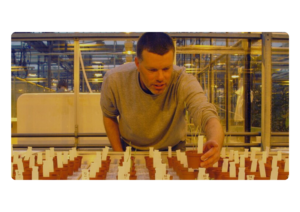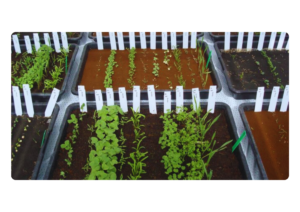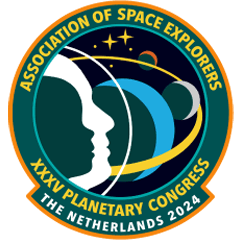11 September 2024 - Esther Sloots
Will we ever be able to grow food on Mars or the moon? And what would that even do for us? These are questions that Dutch ecologist Wieger Wamelink of Wageningen Environmental Research has been researching for more than ten years. The findings are promising and not only provide insights for growing food in space, but also show how we can breathe new life into our soil on Earth.
It all started in the shower, when Wamelink got the idea to investigate whether plants could grow in the soil of Mars and the moon. After some literature research, he discovered that there were no scientific studies on this subject. Wamelink decided not to just work theoretically, but to really start experimenting.
Buckets full of Mars and moon soil
The first hurdle was obtaining fake Mars and moon soil from NASA. It was a logistical challenge to get the 100 kilos of moon soil and 100 kilos of Mars soil, delivered in buckets, to the Netherlands. Customs thought: what is this? Only after paying import duties could the buckets be collected. The real work could begin.
The first hurdle
Wamelink and his team soon discovered a new problem: the Martian soil appeared to be water-repellent, which means that the water simply remained on the surface. ‘I had analyses done in our lab and it turned out that there were very few nutrients for plants in it. For example, the Martian soil mainly lacked nitrogen – which we have far too much of here on Earth. Then you know that you can’t actually grow plants,’ Wamelink explains. The lunar soil contained high levels of toxic metals such as aluminium

Positive results
Nevertheless, Wamelink started experimenting with fourteen plant species, 4200 seeds, including tomatoes, garden cress and rye, a number of wild plants and plants that can withstand difficult conditions, such as nettle and clover. Wamelink thought the chance that anything would germinate was small, but something unexpected happened. ‘It was really amazing to see how quickly the cress and rye grew. Within 24 hours they were already germinating,’ says Wamelink.
The first results were promising and the second experiment also yielded interesting knowledge. ‘We mixed old plant remains through the soil. This made a world of difference. It not only helped to keep the soil more moist, but also improved growth,’ he explains.

In addition, due to a lack of money, Wamelink was forced to let the plants grow together. ‘In retrospect, this turned out to be a golden move,’ says Wamelink with a smile. ‘We have never had such a large yield as that time, because the plants strengthened each other.’ Something that we have completely forgotten in agriculture, according to Wamelink. ‘So called strip cultivation that is now on the rise and which we are also doing a lot of research into, you can see it a bit, but it is still a strip with a monoculture. What we therefore advise is to focus on harvesting with a robot. This of course costs money, but would be an enormous gain for the quality of our soil.’

Growing plants in Martian and lunar soil
‘The techniques we use to grow plants in Martian and lunar soil can really help us restore depleted agricultural lands on Earth,’ says Wamelink. For example, it has been possible to grow plants in the Sinai desert. ‘We looked at how we could revitalize the soil of the Sinai. It is wonderful to see that this is possible and it can also be applied in other dry areas,’ Wamelink adds. This can have a huge impact on depleted agricultural lands worldwide, such as in the Sahara or Kalahari desert, but also closer to home in the Netherlands, where soil depletion and loss of biodiversity are major problems.’
Food production in space
If we ever want people to live on Mars or the moon for research or mining, Wamelink believes it is essential that they can grow food there. Relying on constant food shipments from Earth is not a realistic option.
A recent development in Wamelink’s research is the construction of a dome, a type of greenhouse that is completely sealed off from the outside world. In such a dome, everything can be recycled and it can be used both in space and on Earth, for example in deserts. Wamelink: ‘The idea is that with minimal amounts of water and resources, a sustainable form of agriculture becomes possible, which is why we started B.A.S.E..’

In addition, Wamelink is working with the Netherlands Aerospace Centre (NLR) on the development of a satellite that grows plants in space. This experiment offers new insights for food production in orbit around the Earth. ‘This is an exciting step forward. It can help us to improve food production in space, but also to develop innovations that we can apply on Earth,’ says Wamelink.
Investing in research
Wamelink believes that we as the Netherlands should take our role as an agricultural country seriously and that investing in this research is important. Wamelink: ‘If we invest in innovative research like this now, we can not only contribute to space exploration, but also to solving the problems we experience here on Earth. It is a win-win situation: we improve our agricultural techniques and at the same time help shape the future of space exploration.’
During the XXXV Planetary Congress of the Association of Space Explorers, Wieger Wamelink will give a presentation to astronauts and other experts about his research on Monday afternoon, September 30. Everyone can follow this live via our livestream.




